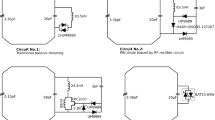Summary
A stereotactic device (SDM) was developed for performing consistent magnetic resonance imaging (MRI) of the rat brain. The SDM was developed by adapting a radiofrequency transmit/receive head coil of 4.4 cm inner diameter (quadrature birdcage head coil), and utilizing partial acrylic construction for the positioning elements. The small head coil provides improved resolution and accuracy of the image, while the stereotactic holder permits repeatable and accurate imaging of identified brain structures.
This system provides several advantages over existing experimental MRI devices. The SDM ensures that the head is always placed in the center of the coil in a uniform fashion. Standardized positioning of the skull optimizes image quality and provides a consistent orientation of the brain. In addition, a widely-utilized coordinate system described by Paxinos and Watson can be employed to assist in the identification of structures and to facilitate surgical planning.
The SDM is compatible with a recently-developed stereotactic device for radiosurgery with the Gamma Knife, thus permitting the planning and performance of experimental radiosurgery using the same coordinate system. The SDM also provides the ability to perform MRI and radiosurgery at different times, thus avoiding the need for prolonged anesthesia during an experimental study. Finally, the SDM allows repeated MRI of the same, identifiable positions in the brain during longitudinal experimental studies. The utility of this device is demonstrated here by examining the time course of cerebral damage that evolved within a radiosurgical focus after gamma irradiation.
Similar content being viewed by others
References
Allegrini PR, Sauer D (1992) Application of magnetic resonance imaging to the measurement of neuro degeneration in rat brain: MRI data correlate strongly with histology and enzymatic analysis. Magn Reson Imag 10: 773–778
Benveniste H, Hedlund LW, Johnson GA (1992) Mechanism of detection of acute cerebral ischemia in rats by diffusion-weighted magnetic resonance microscopy. Stroke 23: 746–754
Bernstein M, Marotta T, Stewart P, Glen J, Resch L, Henkelman M (1990) Brain damage from125I brachytherapy evaluated by MR imaging, a blood-brain barrier tracer, and light and electron microscopy in a rat model. J Neurosurg 73: 585–593
Bernstein M, Ginsberg H, Glen J (1992) Protection of iodine-125 brachytherapy brain injury in the rat with the 21-aminosteroid U-74389F. Neurosurgery 31: 923–928
Green SA, Thurmon JC (1988) Xylazine — a review of its pharmacology and use in veterinary medicine. J Vet Pharmacolo Ther 11: 295–313
Kamiryo T, Berk HW, Lee KS, Kassell NF, Steiner L (1994) A stereotactic device for experimental Gamma Knfe radiosurgery in rats — a technical note. Acta Neurochir (Wien) 125: 156–160
Lo EH, Frankel KA, Steinberg GK, Delapaz RL, Fabrikant JI (1992) High-dose single-fraction brain irradiation: MRI, cerebral blood flow, electrophysiological, and histological studies. Int J Radiat Oncol Biol Phys 22: 47–55
Oldfield EH, Friedman R, Kinsella T, Moquin R, Olson JJ, Orr K, DeLuca AM (1990) Reduction in radiation-induced brain injury by use of pentobarbital or lidocaine protection. J Neurosurg 72: 737–744
Olson JJ, Friedman R, Orr K, Delaney T, Oldfield EH (1990) Cerebral radioprotection by pentobarbital: dose-response characteristics and association with GABA agonist activity. J Neurosurg 72: 749–758
Paxinos G, Watson C (1986) The rat brain in stereotaxic coordinates, 2nd Ed. Academic Press, Florida
Paxinos G, Watson C, Pennisi M,et al (1985) Bregma, and the interaural midpoint in stereotaxic surgery with rats of different sex, strain and weight. J Neurosci Meth 13: 139–143
Prielmeier F, Merboldt KD, Hänicke W, Frahm J (1993) Dynamic high-resolution MR imaging of brain deoxygenation during transient anoxia in the anesthetized rat. J Cereb Blood Flow Metab 13: 889–894
Sauer D, Allegrini PR, Thedinga KH, Massieu L, Amacker H, Fagg GE (1992) Evaluation of quinolinic acid induced excitotoxic neurodegeneration in rat striatum by quantitative magnetic resonance imaging in vivo. J Neurosci Meth 42: 69–74
Sevick RJ, Kanda F, Mintorovitch J, Arieff AI, Kucharczyk J, Tsuruda JS, Norman D, Moseley ME (1992) Cytotoxic brain edema: assessment with diffusion-weighted MR imaging. Radiology 185: 687–690
Smith DA, Clarke LP, Fiedler JA, Murtagh FR, Bonaroti EA, Sengstock GJ, Arendash GW (1993) Use of a clinical MR scanner for imaging the rat brain. Brain Res Bull 31: 115–120
Wolf RFE, Lam KH, Mooyaart EL, Bleichrodt RP, Nieuwenhuis P, Schakenraad (1992) Magnetic resonance imaging using a clinical whole body system: an introduction to a useful technique in small animal experiments. Lab Anim 26: 222–227
Author information
Authors and Affiliations
Rights and permissions
About this article
Cite this article
Kamiryo, T., Berr, S.S., Lee, K.S. et al. Enhanced magnetic resonance imaging of the rat brain using a stereotaetic device with a small head coil: Technical note. Acta neurochir 133, 87–92 (1995). https://doi.org/10.1007/BF01404955
Issue Date:
DOI: https://doi.org/10.1007/BF01404955



